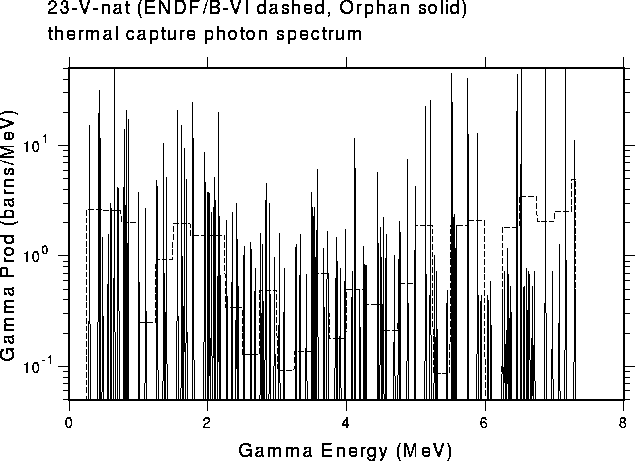
| Nuclear data are important for a number of industrial applications outside of the nuclear power industry. We will highlight a few of them here. |
 |
It is clearly in our national interests to make the best possible use of our declining reserves of natural gas and oil for the sake of US consumers, the health of our petroleum industry, and the condition of our foreign trade deficit. We need to field the best technology that we can to help meet this goal. A detailed knowledge of the geologic strata of existing fields and possible new producing areas is always very important. One probe of the stratigraphy is "nuclear well logging." |
|
A "tool" consisting of a small pulsed neutron source and an array of
detectors is lowered down into a well or a test bore hole. When it is
energized, a pulse of neutrons travels out into the surrounding
formation. Neutrons and photons from nuclear reactions in the formation
and neutrons scattered from the materials return to the tool and are
recorded by the detectors. With good nuclear data and a careful
analysis of the transport of the neutrons and photons through the
surrounding materials (including the materials of the tool and the bore-hole
casing), a great deal of information can be obtained on the details
of the geologic formations. Recently, a Cooperative Research and Development Agreement (CRADA) was established between the US Department of Energy and several companies active in nuclear well logging with the goal of improving the technology for this important field. It is called the Advanced Computational Technology Initiative Program, or ACTI for short. Improved nuclear data is a part of this program, the main emphasis being on improved high-resolution representations of the gamma-ray lines from nuclear reactions. Materials of interest clearly include H and O for water; H and C for hydrocarbons; Na, Cl, and K for salt water and salt beds; Si and O for rock; Ca, C, and O for limestone; trace metals for identifying minerals; and structural materials for modeling the tool and the well casing. In fact, just about everying with atomic charge number through Z=40 is of interest. Of course, there are already existing nuclear data evaluations for most of these materials. However, the accuracy and resolution needed for the well logging application are higher than those needed by industries like nuclear power that supported the development of the existing data files. As an example, the following figure shows the standard gamma-ray spectrum for thermal neutron capture in vanadium from ENDF/B-VI compared to a recent high-resolution evaluation done for the ACTI program. |

|
The new evaluation will clearly provide much better discrimination
for identifying minerals containing vanadium, especially for a
well-logging tool containing a high-resolution gamma-ray detector. Some More Advanced Details The neutron generator in a well logging tool normally produces neutrons with a fairly high energy of 14 MeV. Some of these neutrons will react with materials in the geologic strata to produce secondary neutrons and gamma rays, and some will scatter off the nuclei in the materials and lose part of their energy. Eventually, a portion of the source neutrons will reach thermal equilibrium in the rock, an average neutron energy of .025 eV. Thus, good nuclear data are needed for all neutron energies, but 14 Mev (right after the pulse) and thermal (because of high cross sections for the reactions) are the most important. Thermal neutron gamma-ray spectra for many elements and isotopes have been measured by putting samples in nuclear reactors. These experiments were often performed to better understand the physics of nuclear structure, but the results are also useful for practical projects like nuclear well logging. To get the best accuracy, it is necessary to do a careful review of both elemental and isotopic experiments and resolve the discrepancies. It is not currently possible to predict the energy and strength of gamma lines from thermal capture, but theory can be applied to check the self consistency of the evaluated line structure. Some features of the gamma-ray spectra at high energies can be analyzed using modern nuclear models, but the locations of discrete gamma lines still come from experiment. However, it is necessary to use these nuclear models to extract the best possible representation for the underlying nuclear data from the measurements that are available. One of the best existing models for this purpose is the preequilibrium statistical-model code GNASH from our group at Los Alamos. The response observed in the tool is not directly proportional to the nuclear data; it has been modified by transport through the materials of the surrounding medium, the structure of the tool itself, and the characteristic response of the detector. This part of the problem can be solved by doing a sophisticated nuclear transport calculation using either Monte Carlo or deterministic methods. The calculational methods supported by the transport group at Los Alamos are being enhanced for these purposes under the ACTI program. |